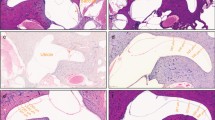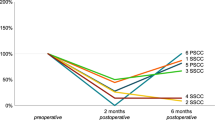Abstract
The diagnosis of bilateral vestibulopathy (BV) is typically established based on bilateral semicircular canal dysfunction. The degree to which both otolith organs—the saccule and utricle—are also impaired in BV is not well-established, particularly with respect to the etiology and severity of BV. The aim of this study was to evaluate semicircular canal, saccular and utricular function in patients with BV due to aminoglycoside ototoxicity and bilateral Menière’s disease, and with different severities of BV. Caloric and head impulse testing were used as measures of canal function. Cervical vestibular-evoked myogenic potentials (cVEMP) and ocular VEMPs (oVEMP) were used as measures of saccular and utricular function, respectively. We enrolled 34 patients with BV and 55 controls in a prospective case–control study. Patients with BV were less likely to have saccular (61 %) or utricular (64 %) dysfunction relative to canal dysfunction (100 %). Utricular function differed significantly between patients by etiologic group: the poorest function was found in patients with BV due to aminoglycoside toxicity, and the best function in Menière’s disease patients. Canal and saccular function did not vary according to etiology. Further, utricular but not saccular function was significantly correlated with canal function. Saccular and utricular function had the strongest association with Dizziness Handicap Inventory scores relative to canal function. These data suggest that when a patient with BV is identified in a clinical context, oVEMP testing is the most sensitive test in distinguishing between aminoglycoside toxicity and bilateral Menière’s disease. Both cVEMP and oVEMP testing may be considered to evaluate the functional impact on the patient.


Similar content being viewed by others
References
Minor LB (1998) Gentamicin-induced bilateral vestibular hypofunction. JAMA 279(7):541–544
Zingler VC, Cnyrim C, Jahn K et al (2007) Causative factors and epidemiology of bilateral vestibulopathy in 255 patients. Ann Neurol. 61(6):524–532
Vibert D, Liard P, Hausler R (1995) Bilateral idiopathic loss of peripheral vestibular function with normal hearing. Acta Otolaryngol 115(5):611–615
Rinne T, Bronstein AM, Rudge P, Gresty MA, Luxon LM (1998) Bilateral loss of vestibular function: clinical findings in 53 patients. J Neurol 245(6–7):314–321
Baloh RW, Honrubia V, Yee RD, Hess K (1984) Changes in the human vestibulo-ocular reflex after loss of peripheral sensitivity. Ann Neurol 16(2):222–228
Zingler VC, Weintz E, Jahn K et al (2008) Saccular function less affected than canal function in bilateral vestibulopathy. J Neurol 255(9):1332–1336
Fujimoto C, Murofushi T, Chihara Y, Suzuki M, Yamasoba T, Iwasaki S (2009) Novel subtype of idiopathic bilateral vestibulopathy: bilateral absence of vestibular evoked myogenic potentials in the presence of normal caloric responses. J Neurol 256(9):1488–1492
Halmagyi GM, Curthoys IS (1988) A clinical sign of canal paresis. Arch Neurol 45(7):737–739
Welgampola MS, Colebatch JG (2005) Characteristics and clinical applications of vestibular-evoked myogenic potentials. Neurology 64(10):1682–1688
Welgampola MS, Migliaccio AA, Myrie OA, Minor LB, Carey JP (2009) The human sound-evoked vestibulo-ocular reflex and its electromyographic correlate. Clin Neurophysiol 120(1):158–166
Jorns-Haderli M, Straumann D, Palla A (2007) Accuracy of the bedside head impulse test in detecting vestibular hypofunction. J Neurol Neurosurg Psychiatry 78(10):1113–1118
Brandt T, Strupp M (2005) General vestibular testing. Clin Neurophysiol 116(2):406–426
Jacobson GP, Newman CW (1990) The development of the Dizziness Handicap Inventory. Arch Otolaryngol Head Neck Surg 116(4):424–427
McCue MP, Guinan JJ Jr (1997) Sound-evoked activity in primary afferent neurons of a mammalian vestibular system. Am J Otol 18(3):355–360
Murofushi T, Curthoys IS (1997) Physiological and anatomical study of click-sensitive primary vestibular afferents in the guinea pig. Acta Otolaryngol 117(1):66–72
Welgampola MS, Carey JP (2010) Waiting for the evidence: VEMP testing and the ability to differentiate utricular versus saccular function. Otolaryngol Head Neck Surg 143(2):281–283
Nguyen KD, Welgampola MS, Carey JP (2010) Test-retest reliability and age-related characteristics of the ocular and cervical vestibular evoked myogenic potential tests. Otol Neurotol 31(5):793–802
Iwasaki S, Smulders YE, Burgess AM et al (2008) Ocular vestibular evoked myogenic potentials to bone conducted vibration of the midline forehead at Fz in healthy subjects. Clin Neurophysiol 119(9):2135–2147
Curthoys IS (2010) A critical review of the neurophysiological evidence underlying clinical vestibular testing using sound, vibration and galvanic stimuli. Clin Neurophysiol 121(2):132–144
Curthoys IS, Kim J, McPhedran SK, Camp AJ (2006) Bone conducted vibration selectively activates irregular primary otolithic vestibular neurons in the guinea pig. Exp Brain Res 175(2):256–267
Smulders YE, Welgampola MS, Burgess AM, McGarvie LA, Halmagyi GM, Curthoys IS (2009) The n10 component of the ocular vestibular-evoked myogenic potential (oVEMP) is distinct from the R1 component of the blink reflex. Clin Neurophysiol 120(8):1567–1576
Kim S, Oh YM, Koo JW, Kim JS (2011) Bilateral vestibulopathy: clinical characteristics and diagnostic criteria. Otol Neurotol 32(5):812–817
Wiest G, Demer JL, Tian J, Crane BT, Baloh RW (2001) Vestibular function in severe bilateral vestibulopathy. J Neurol Neurosurg Psychiatry 71(1):53–57
Matsuzaki M, Murofushi T (2001) Vestibular evoked myogenic potentials in patients with idiopathic bilateral vestibulopathy. Report of three cases. ORL J Otorhinolaryngol Relat Spec 63(6):349–352
Brantberg K, Lofqvist L (2007) Preserved vestibular evoked myogenic potentials (VEMP) in some patients with walking-induced oscillopsia due to bilateral vestibulopathy. J Vestib Res 17(1):33–38
Agrawal Y, Zuniga MG, Davalos-Bichara M et al (2012) Decline in semicircular canal and otolith function with age. Otol Neurotol 33(5):832–839
Merchant SN, Velazquez-Villasenor L, Tsuji K, Glynn RJ, Wall C 3rd, Rauch SD (2000) Temporal bone studies of the human peripheral vestibular system. Normative vestibular hair cell data. Ann Otol Rhinol Laryngol Suppl 181:3–13
Hirvonen TP, Minor LB, Hullar TE, Carey JP (2005) Effects of intratympanic gentamicin on vestibular afferents and hair cells in the chinchilla. J Neurophysiol 93(2):643–655
Iwasaki S, Chihara Y, Smulders YE et al (2009) The role of the superior vestibular nerve in generating ocular vestibular-evoked myogenic potentials to bone conducted vibration at Fz. Clin Neurophysiol 120(3):588–593
Park HJ, Migliaccio AA, Della Santina CC, Minor LB, Carey JP (2005) Search-coil head-thrust and caloric tests in Meniere’s disease. Acta Otolaryngol 125(8):852–857
Horner KC (1993) Review: morphological changes associated with endolymphatic hydrops. Scanning Microsc 7(1):223–238
Lempert T, Gianna CC, Gresty MA, Bronstein AM (1997) Effect of otolith dysfunction. Impairment of visual acuity during linear head motion in labyrinthine defective subjects. Brain 120(Pt 6):1005–1013
Herdman SJ (1998) Role of vestibular adaptation in vestibular rehabilitation. Otolaryngol Head Neck Surg 119(1):49–54
Basta D, Rossi-Izquierdo M, Soto-Varela A et al (2011) Efficacy of a vibrotactile neurofeedback training in stance and gait conditions for the treatment of balance deficits: a double-blind, placebo-controlled multicenter study. Otol Neurotol 32(9):1492–1499
Della Santina CC, Migliaccio AA, Hayden R et al (2010) Current and future management of bilateral loss of vestibular sensation—an update on the Johns Hopkins Multichannel Vestibular Prosthesis Project. Cochlear Implants Int 11(Suppl 2):2–11
Conflicts of interest
The authors declare that they have no conflict of interest.
Ethical standard
All human studies must state that they have been approved by the appropriate ethics committee and have therefore been performed in accordance with the ethical standards laid down in the 1964 Declaration of Helsinki.
Author information
Authors and Affiliations
Corresponding author
Rights and permissions
About this article
Cite this article
Agrawal, Y., Bremova, T., Kremmyda, O. et al. Semicircular canal, saccular and utricular function in patients with bilateral vestibulopathy: analysis based on etiology. J Neurol 260, 876–883 (2013). https://doi.org/10.1007/s00415-012-6724-y
Received:
Revised:
Accepted:
Published:
Issue Date:
DOI: https://doi.org/10.1007/s00415-012-6724-y




